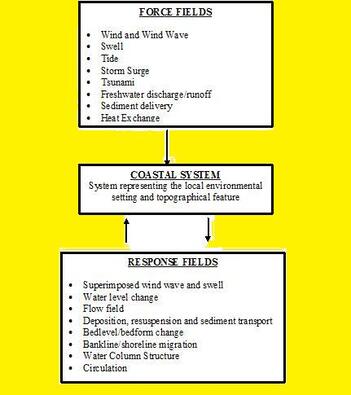Science and technology
working with nature- civil and hydraulic engineering to aspects of real world problems in water and at the waterfront - within coastal environments
 In this piece let us attempt to see in simple terms – the dynamics of coastal systems through a different scientific angle. This angle is the Force Field Theory (or ENERGY FIELD) first proposed by Michael Faraday (1791 – 1867) in 1845 (see The Quantum World; for a short introduction of the concept). A Coastal Engineer’s works, or widely the works of a Civil Engineer belong to the domain of Gravitational Force Field, GFF – formulated by Isaac Newton’s (1642 – 1727) Universal Law of Gravitation (ULG); and its dynamic characterization by Albert Einstein’s (1879 – 1955) General Theory of Relativity (see Einstein’s Unruly Hair). The GFF is a ubiquitous invisible field that affects everything on the Earth’s gravitation field. It defines all the downslope processes, and establishes the necessity of doing work to create upslope events (see Upslope Events and Downslope Processes). We vividly see the gravitational active force in fast flowing streams – and the gravitational restoration force in waves. In all of a Civil Engineer’s works – the universal gravitational acceleration ‘g’ is present (for all practical purposes, g = 9.81 m/s^2 on Earth’s surface). This value appears in almost every relation – with the mass or density (mass per unit volume) of a substance – together they define the weight of the gravitational force. To be in perspective, while GFF defines the Natural World; as a member of the Quantum Field (QF) family, the EMFF is ubiquitous and defines the world of electromagnetism. Perhaps the dynamics of a coastal system – for that matter of any open system on Earth’s surface – can be viewed for convenience, in terms of external excitation or agitation forces on a system – and its internal balancing responses. Alternatively, this duo represents Action-Reaction Fields – in terms of Newton’s Equation of motion translated into Navier-Stokes Equation (see Seabed Roughness in Coastal Waters). I have presented an early version (shown in the image) of the force-response field concept quite a while ago while giving a seminar at UBC and later at the University of Central Florida – where force and response fields were shown separately defining the dynamics of a coastal system. For simplicity of discussions, I like to discuss the coastal dynamics in terms of five interactive Force Fields: (1) Metocean Force Field, MOFF; (2) Extraterrestrial Force Field, ETFF; (3) Land Drainage Force Field, LDFF; (4) Heat Exchange Force Field, HEFF; and (5) Frontal Wave Force Field, FWFF. The hydro-sediment-seabed dynamics responding to these imposed forces are discussed in these five force fields. I have also included a brief on the Structure Response Field (if structures are present). . . . A different way of looking at the Force Field Systems is through the Hydrodynamic Entropy as proposed in Entropy and Everything Else. All the force fields impart energy into water – transforming its dynamic characteristics. One very obvious example is the effect of a Frontal Wave Force Field – in transforming the dynamic characteristics of the medium – e.g. an oscillatory wave transforming into a translatory wave – generating the cascade of dissipation processes. Let me attempt to refresh our understanding of a coastal system – based on pieces posted earlier: Coastal Water and Civil Engineering on our Seashore. A coastal system where the above interactive force fields function – is defined by two vertical boundaries (or the continuity of such boundaries into one or more depending on the type of physical barriers) and two horizontal boundaries (see more in Water Modeling piece). The horizontals are the water surface through which it interacts with air – and the seabed, where it interacts with bottom resistance or reactive force. The verticals are: the open water boundary through which it interacts with its neighbors – and the shoreline of the topographical resistance or reactive force. One can also define other systems for the convenience of analysis and purpose (see Entropy and Everything Else). . . . Metocean Force Field
Extraterrestrial Force Field
Land Drainage Force Field
Heat Exchange Force Field
Frontal Wave Force Field
. . . Let me finish this piece with a Koan: People are the most important institution. Irrespective of the governing system – if those in power fail to uphold the trust and confidence of this institution – of people’s aspiration and wellbeing – then the governance turns into tyranny. . . . . . - by Dr. Dilip K. Barua, 25 August 2021
0 Comments
Leave a Reply. |